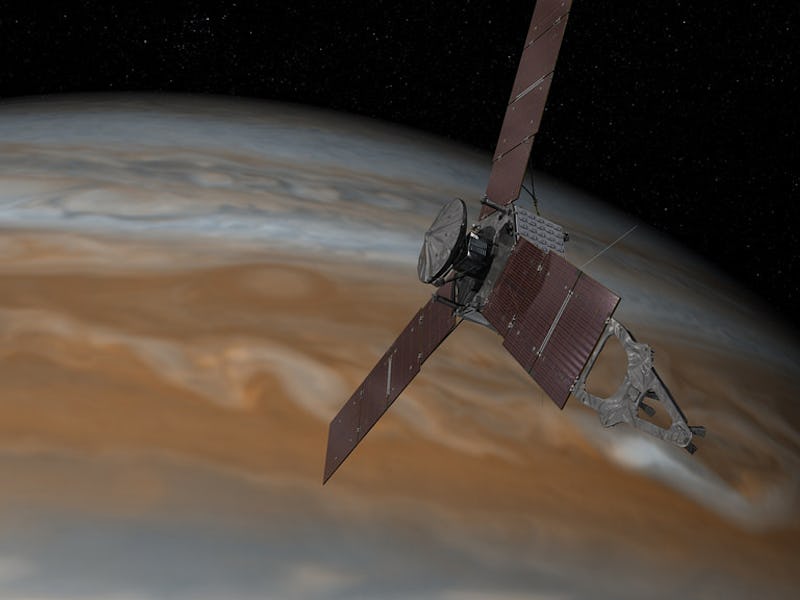What’s Next for 'Juno'?
The NASA spacecraft made it to Jupiter in one piece. Here’s what it will be doing over the next 20 months.

A very late, anxiety-ridden night on Monday ended with cheers and high fives at NASA’s Jet Propulsion Laboratory, as the spacecraft Juno wedged its way into Jupiter’s orbit to begin a 20-month study of the planet, unlock its secrets, and better understand the origins of the solar system’s biggest and most flamboyant celestial body after the Sun.
Now that the hard part is over and Juno has completed the 1.75 billion mile journey from Earth to Jupiter, the fun truly begins. Which leads us to our main concern here: What’s Juno going to be doing over the next several months?
Jupiter is thought to be the first planet to have formed in the solar system, so studying it gives scientists the best chance of understanding the early origins of the Milky Way. NASA is definitely curious about how much water is contained within the gas giant and whether or not there’s a rocky core at the center of the body, among other queries.
NASA turned off the spacecraft’s scientific instruments in order to ensure the focus was on getting Juno past Jupiter’s radiation belts and debris rings and into the red planet’s orbit, swerving about the planet’s north and south poles. The Juno team will turn those instruments back on very soon to start collecting data about the chemical composition of Jupiter’s atmosphere, the potential geology of the planet, and measuring the effects of Jupiter’s magnetosphere and gravitational forces.
Still, the planet is limited by a 53-day orbital distance right now. On August 27, Juno will swing back around the planet for its next best close-up and probably snap up the most detailed images of the planet we’ve ever seen.
Then, on October 19, Juno will undergo another main engine burn to bring it closer to the surface and move itself into a 14-day orbit. That’s when the major scientific studies can finally begin.
Why does NASA care to investigate water? That question is really asking how much oxygen Jupiter possesses. The planet has pretty robust concentrations of heavier elements like nitrogen and carbon — even more so than the sun. But so far, scientists aren’t detecting very much oxygen. It’s possible that those oxygen atoms might be tied up with hydrogen atoms to make up water. If Jupiter does have a lot of water, scientists can assume Jupiter was initially born farther out from the sun, and later found its way into a closer orbit.
Jupiter rotating
There’s also the question of a rocky core. If Jupiter has a rocky core, scientists can use Juno’s geological data to better understand how planets form. If not, then it might be a sign that Jupiter initially formed out of a gas cloud like stars do — and perhaps the gas giant is the aftermath of a failed star.
One of the unique features about Juno is the citizen-science initiative behind the JunoCam. On November 3, the public will be able to start voting on where the spacecraft’s JunoCam should be pointed for photos. Amateur astronomers will be able to download and analyze these images, and upload their data online for other scientists to use.
If all goes well, on February 20, 2018, Juno will take a suicidal dive into the planet it will have studied so intimately and be consumed and destroyed. The purpose is two-fold — to collect more data about the planet through more direct measurements (assuming those instruments are still working), and to rid itself of any microbial contaminants that hitched a ride from its launch from Earth. The Galileo spacecraft was destroyed the same way back in 2003.
An artist's impression of the Galileo probe descending into Jupiter's atmosphere.
The mission might actually be extended past February 2018, but more than likely, the planet’s radiation will have degraded the spacecraft’s instruments and will cease to work well enough to allow for further study.
Right now, NASA does not have a mission lined up to study any planet or moon in the solar system besides Mars after the conclusion of the Juno mission. Plenty of scientists are pushing for a study of Saturn’s moons Titan or Enceladus, but so far, it looks like NASA will be focusing nearly all of its efforts on studying Mars, and getting astronauts to the red planet in the next couple decades.